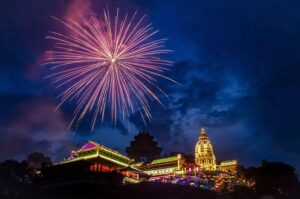Exploring the History of Early Fireworks and Fire Arrows
Fireworks have fascinated people for centuries, their colorful explosions lighting up the night sky in displays of celebration and wonder. Yet, their origins trace back to ancient times, when they served purposes beyond mere entertainment. Let’s delve into the captivating history of early fireworks and fire arrows, unraveling their cultural significance and technical evolution.
Early Beginnings: Fire Arrows
Fire arrows represent one of humanity’s earliest attempts at using combustibles for both warfare and ceremonial purposes. Dating back to ancient China, these arrows were tipped with flammable materials like pitch, resin, or oil-soaked fabric. The concept was simple yet effective: ignite the arrow before launching it toward enemy structures or personnel, creating chaos and destruction.
Frequently Asked Questions:
1. When were fire arrows first used?
Fire arrows were first documented in China around the 9th century BC during the Zhou Dynasty. They were used in both warfare and ceremonial contexts.
2. How were fire arrows made?
Fire arrows were typically made by wrapping combustible materials around the shaft of an arrow. These materials could include pitch, tar, or even gunpowder in later developments.
3. What were fire arrows used for?
Fire arrows were primarily used for setting enemy structures or ships ablaze during sieges, disrupting formations, and causing panic among enemy troops.
Evolution into Early Fireworks
The transition from fire arrows to fireworks was gradual and driven by the exploration of gunpowder in ancient China. Initially developed for military use, gunpowder—a mixture of saltpeter, sulfur, and charcoal—soon found its way into pyrotechnic applications.
Frequently Asked Questions:
1. Who invented fireworks?
While the exact inventor of fireworks is unknown, it’s widely believed that they originated in ancient China around the 7th century AD, evolving from experiments with gunpowder.
2. What were early fireworks used for?
Early fireworks were used in China for both entertainment and religious ceremonies, such as celebrations of the Lunar New Year and other important festivals.
3. How did fireworks spread around the world?
Fireworks spread from China along trade routes, reaching the Middle East, Europe, and the Americas through cultural exchanges and conquests.
Cultural Significance
Beyond their technical development, fireworks and fire arrows hold profound cultural significance. In China, fireworks are believed to ward off evil spirits through their loud noises and bright flashes. Over time, fireworks became symbols of joy, marking celebrations, weddings, and religious ceremonies across various cultures.
In Europe, fireworks became popular during the Renaissance, captivating audiences with intricate designs and explosive displays. They were incorporated into royal festivities and public events, solidifying their status as a spectacle of artistry and celebration.
Modern-Day Impact
Today, fireworks continue to dazzle audiences worldwide, from grand national celebrations to intimate backyard gatherings. Advances in chemistry and engineering have refined their colors, shapes, and safety, ensuring that each display is more awe-inspiring and safer than ever before.
In conclusion, the history of early fireworks and fire arrows spans millennia, reflecting humanity’s ingenuity and creativity in both warfare and celebration. From ancient China to the global stage, these pyrotechnic marvels continue to captivate hearts and minds, reminding us of our shared cultural heritage and the enduring allure of a spectacular display.

How to make Fireworks in Minecraft
Making fireworks in Minecraft can be a fun and creative activity, especially for celebrating in-game events or just adding some visual flair to your world. Here’s a step-by-step guide on how to make fireworks in Minecraft:
Requirements:
- Materials:
- Gunpowder (1 per firework rocket)
- Paper (1 per firework rocket)
- Optional: Dyes (for colored fireworks)
- Crafting Table:
- Access to a crafting table or a player’s 2×2 crafting grid.
Step-by-Step Guide:
- Obtain Gunpowder:
- Gunpowder is dropped by creepers when they are defeated. You’ll need one gunpowder per firework rocket you want to craft.
- Craft Paper:
- Craft paper from sugar cane. Collect sugar cane, which grows near water, and craft it into paper using a crafting table. You’ll need one paper per firework rocket.
- Craft Firework Stars (Optional for Colored Fireworks):
- To create colored fireworks, craft firework stars first. Firework stars determine the color, effect, and shape of the fireworks.
- Combine gunpowder, any dye of your choice, and an optional additional item (like glowstone dust for a twinkle effect, or diamond for a trail effect) in a crafting table or your crafting grid. This creates a firework star.
- Craft Firework Rockets:
- Place one piece of gunpowder and one piece of paper in a crafting table or your crafting grid. This will create a firework rocket.
- If you crafted firework stars in the previous step, combine the firework star with the firework rocket in a crafting table. This will add the effects and colors to your fireworks rocket.
- Experiment with Different Combinations:
- You can experiment with different combinations of dyes and fireworks stars to create various effects. For example, combining different dyes in a firework star will result in a multicolored firework.
- Launch Your Fireworks:
- Place your crafted fireworks in your hot bar.
- Right-click (or use the equivalent action on your device) to launch it into the sky.
- Enjoy the show!
Tips:
- Experimentation: Don’t hesitate to experiment with different combinations of dyes and it stars to create unique fireworks.
- Storage: Store your crafted fireworks safely in chests to use them later or for special events.
- Redstone: For more advanced setups, you can use redstone mechanisms to automate the launching of fireworks in Minecraft.
Creating fireworks in Minecraft adds a festive and celebratory element to your gameplay, making your in-game events and gatherings even more memorable. Enjoy crafting and launching your fireworks in the world of Minecraft!
How Do Fireworks Work: The Science behind the Fireworks
Fireworks function through a series of controlled chemical reactions that create explosive and colorful displays. When a firework is ignited, the heat travels along a fuse to a lift charge at the base of the shell, typically made of black powder. This charge propels the firework into the air from a mortar tube. As it reaches a certain height, a timed fuse ignites a burst charge within the shell, setting off small pellets called stars. These stars contain metal salts and other compounds that produce brilliant colors and special effects like strobing or crackling. The specific color of light emitted by the stars depends on the type of metal salt used:

- Strontium: Red
- Calcium: O
- range
- Sodium: Yellow
- Barium: Green
- Copper: Blue
- Strontium + Copper: Purple
- Magnesium, Aluminum + Titanium: White
Fireworks are meticulously designed to create varied visual and auditory experiences, making them a staple of celebrations worldwide.
Components of Fireworks:
- Shell or Rocket:
- The outer casing of a firework contains all the components and is designed to explode in the air.
- Propellant:
- Typically gunpowder or another pyrotechnic composition propels the firework into the air.
- Fuse:
- A fuse initiates the ignition of the firework. It burns at a controlled rate to allow the firework to reach the desired altitude before detonating.
- Star Composition:
- The heart of the firework display is composed of small pellets or stars made from various chemicals that create colors and effects when ignited.
How Fireworks Work:
- Launch:
- When a firework is ignited (either manually or electrically), the fuse burns, igniting the propellant inside the firework casing.
- Aerial Burst:
- As the firework rises into the sky, the propellant expels gases that create thrust, pushing the firework higher. Once it reaches the desired altitude, the fuse reaches the burst charge.
- Explosion:
- The burst charge inside the firework is ignited by the fuse reaching it. This explosion breaks open the firework’s casing and disperses the stars (pellets).
- Color and Effects:
- Each star contains specific chemical compositions that determine its color and effect. For example:
- Strontium compounds produce red colors.
- Barium compounds produce green colors.
- Copper compounds produce blue colors.
- Magnesium or aluminum produces white or silver colors.
- Different metal salts can produce other colors like yellow (sodium), purple (potassium), and so on.
- Special additives like metals (to create sparks) or chemical mixtures (to create crackling sounds) are also included in some stars.
- Each star contains specific chemical compositions that determine its color and effect. For example:
- Safety and Control:
- Modern forms of it is are carefully designed and controlled to ensure safety and reliability. They include safety fuses and are regulated to prevent accidents.
Types of Fireworks:
- Aerial Shells: Large spherical firework launched from mortar tubes.
- Firecrackers: Small, explosive devices that create loud sounds.
- Roman Candles: Multi-shot fireworks that emit stars and other effects.
- Sparklers: Hand-held firework that emit sparks.
Conclusion:
<p>Fireworks are a fascinating blend of chemistry, physics, and artistry, designed to create dazzling displays in the sky. Understanding how they work involves knowing about the propellants, burst charges, and the chemical compositions of the stars that produce the colors and effects we enjoy. Whether for celebrations, entertainment, or cultural events, firework continue to captivate and inspire people around the world.

